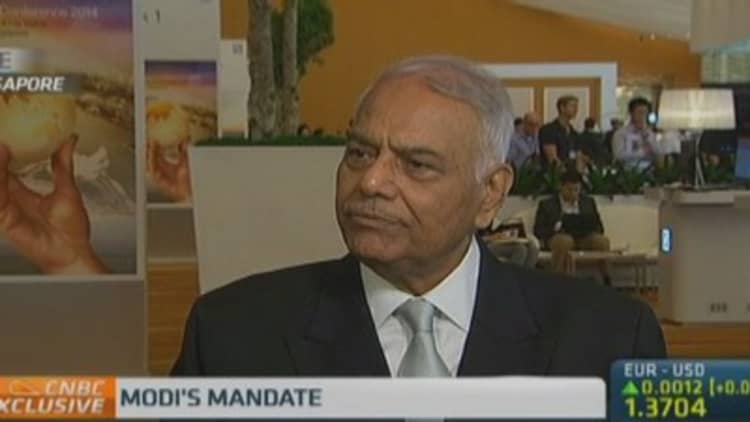Narendra Modi's stunning victory in India's parliamentary election is undoubtedly an affirmation of a contemporary "Indian dream" – the ability of an individual from a disadvantaged background to rise to the height of power and success.
Yet along with its tantalizing promise of greater meritocracy and social mobility in a land of vast socio-economic disparities and entrenched privilege, Mr Modi's win also reflects a darker aspect of India's democracy: the way money power determines political outcomes.
It may never really be known how much money Mr Modi and his Hindu nationalist Bharatiya Janata Party spent on the dazzling, high-tech campaign to persuade millions of voters that he was the man to lead India out of its current economic and governmental malaise.
Read MoreModi wins India election by a landslide
Nor could the scores of trucks and buses – and the army of nearly 4,000 workers – required to move and install the satellite dishes and projectors at one remote site after another.But the technology that permitted Gujarat's chief minister to simultaneously address 100 rallies – in the form of a 10-feet-tall hologram – while images of the crowd were beamed back to him at the BJP's Ahmedabad offices cannot have come cheap.
In Indian cities, bus shelters, billboards and newspaper front pages were plastered with so many advertisements bearing Mr Modi's brooding face it was hard not to feel that Big Brother was indeed watching. Television broadcasts of the popular Indian Premier League cricket matches also aired a relentless series of Modi ads during commercial breaks.
Read MoreThe top 4 priorities for India's new government
Advertising industry executives estimate the BJP spent at least $500 million on traditional media advertising alone. A member of Citizens for Accountable Governance, which helped run Mr Modi's campaign, says the campaign spent around $670 million over eight months. Others say the true spend is probably far higher. A BJP spokeswoman was unable to provide any official estimate at all.

In theory, India has campaign spending limits for parliamentary candidates, which a 1974 Supreme Court ruling said was necessary to ensure fair competition in the market place of ideas. In the just-concluded polls, official spending caps were set at Rs5.4 million to Rs7 million ($93,000 to $120,000) per constituency, depending on the state and the constituency size.
But glaring loopholes render these caps meaningless. Money that candidates spend on self-promotion before filing their nomination papers is not counted, allowing hopefuls to spend big before throwing their hats into the ring. India also does not cap how much political parties can spend on general campaigning, meaning there was no brake at all on Mr Modi's media blitz.
More from the Financial Times:
Credit Suisse pleads guilty to tax evasion
Libya braces for further conflict
Putinorders troops to return to bases
Reform-minded critics have long called for more effective campaign spending limits to improve the health of India's democracy. Yet as troubling as the question of how much money is spent on election is the total lack of transparency of where the money comes from.
Technically, parties are required to report all political contributions over Rs20,000. In reality, to avoid scrutiny, parties simply break large contributions down into multiple tranches, each below the reporting threshold, and report them as cash.
The tendency towards covert donations is rooted, like so many other Indian ills, in the era of Indira Gandhi, who in 1969 banned companies from donating to political parties, as her rivals enjoyed stronger business backing. While the rules have been relaxed since then, many companies prefer to donate from the shadows, rather than under public scrutiny. It is an open secret in Mumbai that many large companies gave generously, if quietly, to Mr Modi's campaign.
Read MoreIndia's Modi gets hero's welcome as he brings new era to New Delhi
In the elections the fledgling Aam Aadmi (or Common Man) Party, dedicated to cleaning-up India's money-driven politics, set a new standard for transparent campaign finance by recording on its website every donation it received. The party, which won just four seats in Parliament, urges its establishment rivals to follow its moral example.
In his own slick campaign, Mr Modi promised Indian voters efficient, accountable and corruption-free governance. Telling voters how much he spent on his national marketing campaign – and who paid for it – would be an excellent way to start.




